|
Friday, May 16
- Breakfast: big country breakfast
- Breakfast: chorizo and egg burrito
- Seafood po' boy
- Smart cuisine: chana masala
- Tuna noodle casserole
- Honey mustard ham and Swiss panino
- Chicken fajitas plate
- Tomato basil bisque
- Texas-style chili
- Assorted pizza by the slice
Wilson Hall Cafe menu
|
|
Friday, May 16
Dinner
Closed
Wednesday, May 21
Lunch
- Spinach- and red pepper-stuffed chicken breast
- Orzo salad
- Strawberry shortcake
Chez Leon menu
Call x3524 to make your reservation.
|
|
Proving special relativity: episode 4
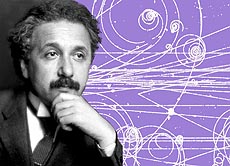 |
| While Einstein's theory of special relativity is one of the most mind-bending and nonintuitive ideas of the last century, it turns out that there is a single insight that makes it all seem far more sensible.
|
Read the full column on proving special relativity
Over the past few Physics in a Nutshell columns, we have talked about Einstein's theory of special relativity and how the operational experience of particle accelerators shows that the theory is true. But there's a difference between knowing that something is true and understanding why it is true. It is the nonintuitive logic of special relativity that makes so many people resist believing it. But it will all make sense when you understand just a relatively small number of ideas.
The first is the fact that space and time are really the same thing. This is not at all obvious, but it becomes clear when one considers how two observers view a common object (you don't even need to invoke Einstein). For instance, suppose you sit by the side of the road. As far as you are concerned, you don't move. On the other hand, a person driving by at 60 miles per hour will say that your position is changing. Every hour, your position is 60 miles farther away from him. As far as the other person is concerned, your position depends on his time. Space and time are mixed, much the same in the same way that up-down and left-right are essentially equivalent.
Once you've accepted the equivalence of space and time and the existence of space-time, we're almost home free. Our final important point is cinchy to accept in comparison: All things travel at just one speed … the speed of light. In fact, as you sit there, perhaps eating a muffin on your morning coffee break, you are traveling at the speed of light. At such a breakneck speed, perhaps you should hold onto your coffee and muffin just a tad bit more carefully, no?
Read more
—Don Lincoln
Want a phrase defined? Have a question? Email today@fnal.gov.
|
International Linear Collider makes progress in siting, R&D
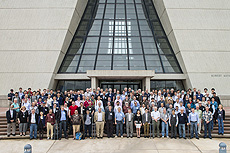 |
Scientists and engineers met at Fermilab this week for the Americas Workshop on Linear Colliders. Photo: Reidar Hahn |
This week, members of the Linear Collider Collaboration met at Fermilab to discuss the progress and future of the proposed International Linear Collider, as well as of CERN's Compact Linear Collider, during the Americas Workshop on Linear Colliders.
At the workshop, scientists and engineers involved in the ILC discussed both their recent successes and the work still to be done to make the 18-mile-long electron-positron collider a reality.
One recent breakthrough took place at KEK. At the Japanese laboratory's Accelerator Test Facility, scientists achieved an electron beam height of 55 nanometers at the final focus, or the point where the collision would occur. This is the smallest electron beam ever produced. It was a demonstration that the techniques scientists used to shrink the beam would be transferable to the ILC, whose aim is an electron beam height of 5 nanometers.
"The ATF at KEK is an essential element in the R&D activity toward a linear collider," said Linear Collider Collaboration Director Lyn Evans. "The latest results give great confidence that the design parameters of a linear collider can be reached."
That electron beam would travel through accelerator cavities — long, hollow niobium structures that look like strings of pearls. Scientists at Fermilab have made significant advancements on this front, achieving world-record quality factors. The so-called quality factor is a measure of how effectively the cavities store energy. The more efficient they are, the lower the cost of refrigeration, which is needed to keep the superconducting cavities cold.
"This workshop at Fermilab gives us the perfect opportunity to interact with the SRF community here at the lab," said ILC Director Mike Harrison. "We take advantage of the workshop to catch up on the latest results at the lab."
For the first time, ILC researchers actively discussed the International Linear Collider in the context of a precise, geographical home — the Kitakami mountains in the Japan's Iwate prefecture. Site pictures and films at the workshop included actual accelerator and detector locations among hills and trees.
"This really gives a sense of reality to the project," said Fermilab Director Nigel Lockyer. "Now the site-specific design work needed to put the ILC in that location can begin in earnest. This has been a long time coming, and we are very pleased with this step forward."
|
Heron goes fishing
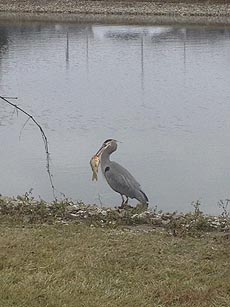 |
| A great blue heron at the pond by Wilson Hall enjoys a snack. Photo: Ken Herner, SCD
|
|
CEBAF beam goes over the hump: highest-energy beam ever delivered at Jefferson Lab
From Interactions.org, May 14, 2014
Newport News, VA, May 14, 2014 - The Continuous Electron Beam Accelerator Facility (CEBAF) at the U.S. Department of Energy's Thomas Jefferson National Accelerator Facility has achieved the final two accelerator commissioning milestones needed for approval to start experimental operations following its first major upgrade.
In the early hours of May 7, the machine delivered its highest-energy beams ever, 10.5 billion electronvolts (10.5 GeV) through the entire accelerator and up to the start of the beamline for its newest experimental complex, Hall D. Then, in the last minutes of the day on May 7, the machine delivered beam, for the first time, into Hall D.
Read more
|
Cosmology: First light
From Nature, May 14, 2014
Cosmologists couldn't have wished for a better anniversary present. Almost 50 years to the day after the first detection of the Big Bang's afterglow — a faint glimmer of long-wavelength photons known as the cosmic microwave background (CMB) — the field has been galvanized by what may be the last major discovery from the radiation.
Read more
|
|
A neutrino tale as told by a proton
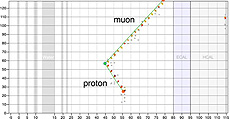 |
| In this candidate event from data, the neutrino scatters off a nucleon and produces a muon and a proton. The muon exits through the side of the detector.
|
Para una versión en español, haga clic aquí. Para a versão em português, clique aqui.
Neutrinos are difficult to study because their interaction with matter is extremely rare. Nonetheless, neutrino experiments do what they can to improve the odds: They use a neutrino beam with as high an energy as possible and build detectors filled with as many protons and neutrons as possible. One thing these detectors have in common is that they see nothing coming in, only something going out when a neutrino does interact in the detector.
Neutrino scientists have to work their way back from those end products to study the neutrino and its interaction with matter. One of these interactions, known as a quasielastic interaction, takes place when the neutrino completely scatters off a neutron in an atom's nucleus, producing a muon and a proton.
Since the 1970s, several experiments have measured the probability of this interaction using different types of detectors. Old experiments used deuterium (which contains exactly one proton and one neutron) as a target. Modern experiments use more complex nuclei such as carbon (six protons and six neutrons), which makes the study of quasielastic interactions very challenging. For example, the end products can interact with other protons and neutrons in the same nucleus after the main interaction, and thus what we measure in the detector is different from what was initially produced. This quasielastic interaction is very important for neutrino oscillation experiments, and current experiments use this interaction as the signal for the analysis.
Recent measurements of this interaction have shown discrepancies between data and theoretical models. Last year, the MINERvA experiment measured everything it could about the outgoing muon. The MINERvA detector is also capable of measuring the outgoing proton. MINERvA recently made a new measurement using information from the proton and including all the events with a muon plus a proton, no matter which way the muon travels through the detector. It is shown exiting through the side of the detector in the above figure.
The new measurement (see below) gives the probability of producing a proton and muon from a neutrino as a function of the momentum given the nucleus (Q2), where we calculate that using only information from the proton. This is the first time a measurement of the protons has ever been made. To see Tammy Walton present these results, please see the recording of the May 9 wine and cheese seminar.
—Minerba Betancourt
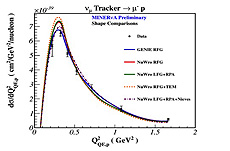 |
| This plot shows the cross section (probability) of producing a proton with respect to Q2, the momentum transferred to the proton (measured using the proton alone). Different models are shown, where each model has been normalized to the data.
|
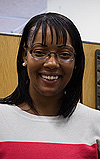 |
| Fermilab's Tammy Walton, formerly of Hampton University, presented this result at last week's Joint Experimental Theoretical Seminar.
|
|
DASTOW 2014 scheduled for Friday, June 20
School-age children of Fermilab employees, users and contractors can see physics up close on Friday, June 20, when they visit Fermilab for Daughters and Sons to Work (DASTOW) day.
Enjoy traditional favorite activities, including Mr. Freeze's cryogenics show, exploring Fermilab Fire Department equipment and lunch in the Wilson Hall atrium.
New to this year's festivities is Physics Fun on 15, hands-on science activities for children offered by Fermilab's Education Office. Please note that you will need to register online for this activity. The deadline is June 18.
Exposing children to the workplace is an excellent way to show them the value of education, help them understand what their parents or relatives do at work and get them thinking about future career options.
This year, DASTOW is scheduled on a Friday from 8:30 a.m. until 1 p.m., allowing time in the afternoon for children to observe their parents while at work. If you choose instead to take vacation time in the afternoon to extend your weekend, please obtain your supervisor's approval in advance.
For a complete schedule of the day's events, visit the DASTOW website.
|
Wilson Street entrance closure extended to May 20
Due to the rain, the Wilson Street entrance closure has been extended until Tuesday, May 20. The gate will reopen on the morning of Wednesday, May 21. Truck deliveries and employees will be rerouted to the Pine Street entrance.
|
|